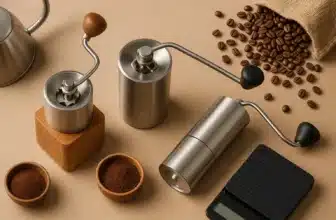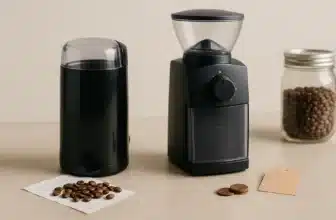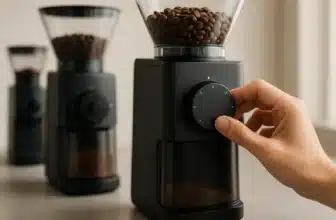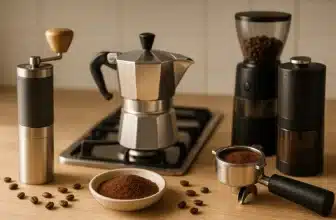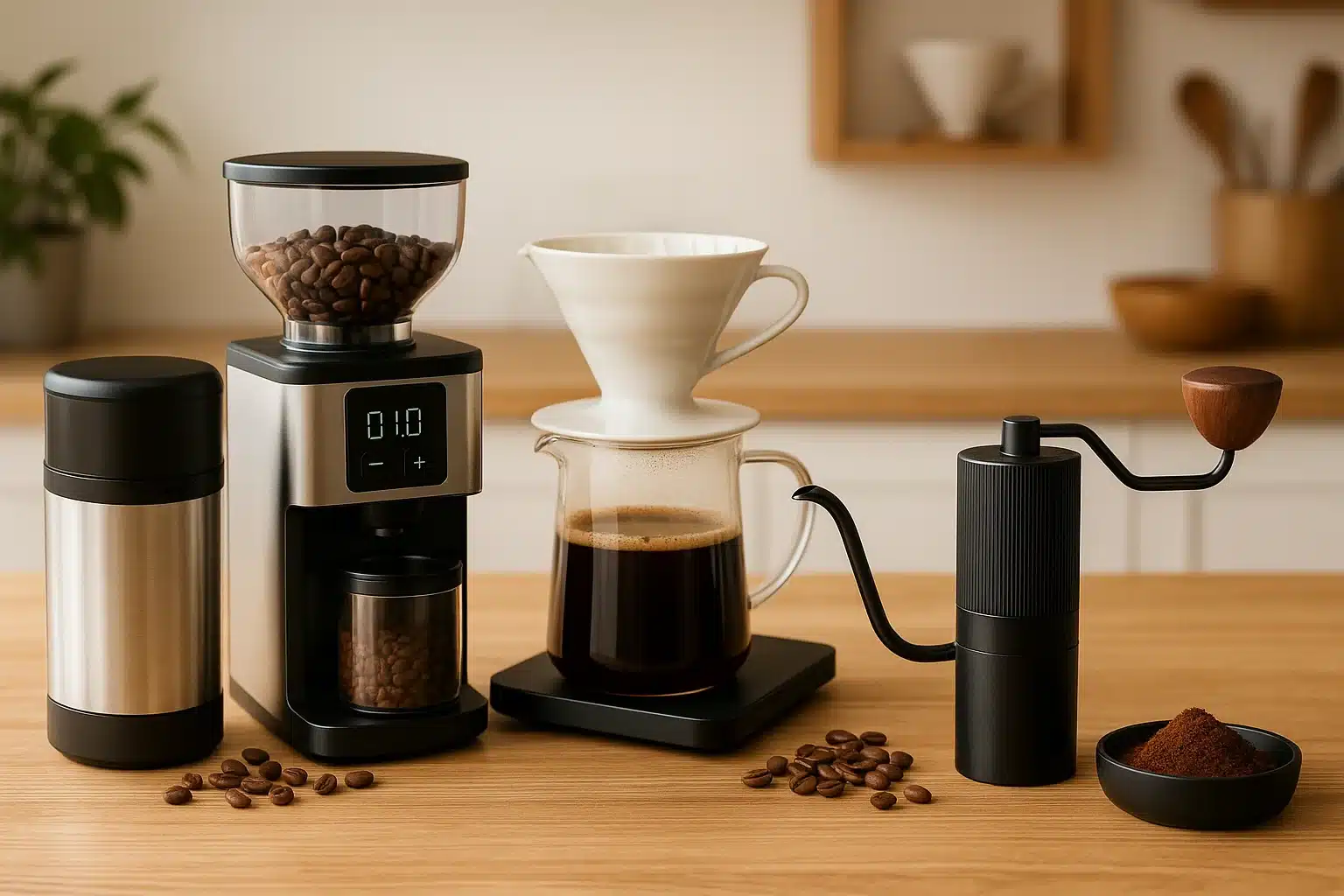
OneHundredCoffee is reader-supported, and some products displayed may earn us an affiliate commission. Details
Pour-over rewards patience and precision. When you get it right—the bloom, the steady spiral, the perfectly timed drawdown—you’re treated to a cup with shimmering clarity and layered sweetness. But none of that happens without the right grind. Particle size is the steering wheel of pour-over: too fine and the brew chokes, turning bitter; too coarse and it races through, tasting weak and sour. That’s why your grinder matters more than almost any other piece of gear.
This guide is all about dialing in pour-over precision on real-world grinders that home brewers actually buy and use. We took a close look at five popular options across budgets and formats:
- Bodum Bistro Electric Blade Coffee Grinder
- Amazon Basics Electric Coffee Grinder
- OXO Brew Conical Burr Coffee Grinder (Matte Black)
- KitchenAid Blade Coffee Grinder
- Hario Ceramic Coffee Mill “Mini-Slim Pro” (manual burr)
Best Coffee Grinders for Pour-Over Precision at A Glance
| Image | Product | Features | Price |
|---|---|---|---|
Best Everyday Grinder  |
| Price on Amazon | |
Best Compact Hand Grinder  |
| Price on Amazon | |
Best Entry-Level Grinder  |
| Price on Amazon | |
Best Simple Blade Grinder  |
| Price on Amazon | |
Best Compact Electric Grinder  |
| Price on Amazon |
Two of these are burr grinders (OXO, Hario) and three are blade grinders (Bodum, Amazon Basics, KitchenAid). For pure particle uniformity, burrs win—every time. But blades can still make a decent pour-over with careful technique, small batch sizes, and some simple tricks. Below you’ll find a big-picture buyer’s guide, an at-a-glance comparison table, and then deep-dive reviews of each model.
Quick Take: Who Should Buy What?
- Best all-around for pour-over: OXO Brew Conical Burr — dependable uniformity, easy controls, great day-to-day grinder.
- Best for travel & quiet brewing: Hario Mini-Slim Pro — excellent manual consistency with portable, metal-accent build.
- Best ultra-budget starter: Amazon Basics Blade — surprisingly usable for pour-over with pulse-and-shake technique.
- Best for small apartments: Bodum Bistro Blade — compact footprint, simple operation, budget-friendly.
- Best for quick single cups: KitchenAid Blade — fast, robust motor; works with short pulses for reasonable results.
Comparison Table (At a Glance)
| Grinder | Burr/Blade | Grind Adjustability | Capacity | Best Use Case | Noise | Portability | Maintenance | Price Tier |
|---|---|---|---|---|---|---|---|---|
| OXO Brew Conical Burr (Matte Black) | Burr (Conical) | Wide, stepped with fine increments | Household batches | Daily pour-over with consistency | Moderate | Countertop | Easy brush/occasional hopper wipe | Mid |
| Hario Mini-Slim Pro | Burr (Ceramic, Manual) | Stepped; easy to fine-tune | 1–2 cups | Travel, quiet mornings | Very low | Excellent | Disassembles easily; hand wash burrs | Low-Mid |
| Bodum Bistro Blade | Blade | Time-based; technique-driven | Small | Entry-level pour-over | Moderate-High | Good | Wipe bowl; avoid water in motor base | Low |
| KitchenAid Blade | Blade | Time-based; technique-driven | Small-Medium | Fast single cups | Moderate-High | Good | Wipe bowl; quick brush | Low-Mid |
| Amazon Basics Blade | Blade | Time-based; technique-driven | Small | Budget starter | Moderate-High | Good | Wipe bowl/brush frequently | Lowest |
Note: Blade grinders don’t have true “settings.” You approximate particle size with short pulses, shaking, and brief rests. Burr grinders have mechanical adjustments that change the burr spacing for repeatable results.
How to Choose a Grinder for Pour-Over (Customer Guide)
1) Burrs vs. Blades
- Burrs (OXO, Hario) crush beans between two surfaces, producing more uniform particles and better flavor clarity. They’re ideal for V60, Kalita Wave, Chemex, and Origami drippers.
- Blades (Bodum, KitchenAid, Amazon Basics) chop beans randomly. You can still brew a nice cup, but you’ll work a bit harder for consistency.
2) Adjustability & Repeatability
Pour-over demands small tweaks day to day. Burr grinders offer stepped or stepless adjustments that let you return to yesterday’s grind easily. With blades, your “setting” is a combination of time, pulse rhythm, shake pattern, and batch size.
3) Heat & Static
Excess heat can mute delicate aromatics; high-speed motors and long grinding sessions can warm grounds. Static causes fines to cling to the bin and scatter. Look for grinders with reasonable RPMs, grounds bins that minimize static, and try to grind just what you need.
4) Capacity & Workflow
Brewing for one? Manual burrs and small electrics are perfect. Making several cups at once? A countertop burr grinder saves time and keeps results consistent.
5) Build & Maintenance
Detachable hoppers/bowls and accessible burrs make cleaning easier. Plan to brush burrs weekly, deep clean monthly, and avoid water on the motor base (for electrics).
6) Budget
If pour-over is your daily ritual, a burr grinder is a long-term flavor investment. If you’re testing the waters, a blade grinder will work with the right technique.
Dialing In for Pour-Over: A Quick Start
- Recipe: Begin around 1:16 (e.g., 22 g coffee to 350 g water).
- Grind: Start medium-fine for V60 (slightly finer than table salt) and medium for Chemex.
- Brew Time: Aim for 2:45–3:30 for most single-cup brews.
- Adjust: If the brew stalls or tastes bitter, coarsen. If it zips through and tastes thin or sour, tighten.
- Blade Technique: Use 5–10 short pulses, shake the grinder gently between pulses to redistribute particles, then stop early and sift out fines if possible.
OXO Brew Conical Burr Coffee Grinder –Best Overall for Pour-Over

OXO Brew Conical Burr Coffee Grinder (Matte Black)
Key Features
- Stainless steel conical burrs for uniform grounds
- 38 grind settings from fine espresso to coarse press
- One-touch start timer remembers last setting
- Large hopper holds up to 12 oz of beans
- Anti-static grounds container reduces mess
Why We Like It
The OXO Brew Conical Burr Grinder balances simplicity and precision. With a wide grind range, intuitive timer, and anti-static design, it’s a dependable daily grinder for drip, pour-over, or espresso lovers.
Pros
- Consistent grind with conical burrs
- Easy-to-use one-touch timer
- Wide range of grind settings
- Generous bean hopper size
Cons
- No digital display or weight-based dosing
- Static can still occur in dry climates
Bottom Line
A practical, reliable burr grinder that delivers consistent results at a fair price—ideal for everyday brewing needs.
Price on AmazonOXO’s conical burr grinder is the friend who shows up on time, gets the job done, and doesn’t make a mess about it. It’s designed for daily drinkers: a clear hopper that’s easy to fill, a grounds bin that slides out smoothly, and a control interface that feels intuitive from the first use. The burrs deliver a noticeably uniform grind in the pour-over range, and that’s the headline: more uniform particles equal more predictable extractions and cleaner flavor in the cup.
Day to day, the OXO shines in repeatability. The stepped dial offers a broad spectrum of usable pour-over settings with fine increments, making it simple to nudge your grind coarser on a bright, dense Ethiopian or a touch finer on a chocolaty Latin American blend. The motor is strong without being shrill, and while you’ll hear it working, it’s a tolerable, kitchen-friendly sound. Grind retention is reasonable; giving the grinder a gentle tap after it stops will clear out the last bit of grounds.
In the cup, the OXO tends to accentuate sweetness and clarity while avoiding over-extraction bitterness that can creep in with uneven grinders. With a V60, we routinely hit target brew times without fuss; with a Chemex, the larger bed of grounds still drained consistently, producing that signature clean, tea-like texture. The grounds bin and chute design also keeps static in check better than many grinders at this price point—your counter will thank you.
Cleaning is manageable. Pop off the hopper, lift out the top burr, and brush everything down in a couple of minutes. A monthly deep clean keeps flavors transparent and your adjustments honest. Build quality feels solid for the category: it’s not “heirloom” heavy, but it’s sturdy enough to be a daily driver for years with normal care.
If your goal is pour-over precision without complexity or a luxury price tag, the OXO is the smart, balanced choice. It’s the grinder we’d recommend to most people who brew filter coffee several times a week and want reliable, repeatable results.
Pros: Uniformity, easy adjustment, low-mess workflow, fair price for performance.
Cons: Not whisper-quiet; plastic bin can carry a bit of static in very dry rooms.
Best for: Daily pour-over drinkers who value consistency and convenience.
Hario Ceramic Coffee Mill “Mini-Slim Pro” — Best for Travel & Quiet Mornings

Hario Mini-Slim Pro Ceramic Coffee Mill
Key Features
- Durable ceramic burrs for consistent grinding
- Slim, portable design with stainless steel handle
- Adjustable grind settings from fine to coarse
- Holds up to 24 grams (2–3 cups) of coffee beans
- Lightweight and ideal for travel or camping
Why We Like It
A trusted manual grinder from Hario—compact, reliable, and built for on-the-go coffee brewing. Its slim profile and consistent burrs make it a favorite for pour-over and Aeropress fans.
Pros
- Lightweight and portable
- Durable ceramic burrs
- Easy to adjust grind size
- Affordable entry-level grinder
Cons
- Small capacity for larger brews
- Manual effort required
Bottom Line
A compact, budget-friendly hand grinder that delivers consistent results—perfect for travelers, campers, and manual brewing enthusiasts.
Price on AmazonHario’s Mini-Slim Pro is a manual burr grinder with a focus on portability, precision, and peace. The body includes metal components for durability, the handle feels secure, and the compact cylinder slips neatly into a bag or drawer. If early-morning serenity matters—or you need a grinder that works on a campsite as well as a countertop—this is your pick.
The ceramic burrs create impressively uniform grounds in the pour-over range. Adjustment is stepped and easy to dial, so once you find the sweet spot for your V60 or Origami, you can keep returning to it without guesswork. Because you power it by hand, there’s virtually no heat buildup, preserving delicate florals and top-note aromatics. And unlike loud electrics, this grinder hums along in near silence—your sleeping housemates will never know you’re crafting a cup at 6 a.m.
Grinding speed depends on strength and dose: expect about a minute for a single cup. That’s the tradeoff—precision and quiet for muscle power and time. In the cup, the Mini-Slim Pro consistently emphasizes clarity and balance. With washed Africans, you’ll notice citrus and stone-fruit notes pop; with natural processed coffees, you’ll get jammy sweetness without muddiness. The uniformity also helps keep drawdown times predictable, making your blooming and pouring routine feel calm and repeatable.
Maintenance is a breeze. The grinder disassembles tool-free, so you can brush burrs and rinse non-metal parts when needed (dry thoroughly). The build feels more premium than typical entry-level manuals, and the handle socket doesn’t wobble or slip when you get to the harder bits of grinding.
If you mostly brew single cups and want excellent pour-over control without adding noise or cost, the Mini-Slim Pro is a gem. As a travel grinder, it’s hard to beat; as a home grinder, it’s a quiet, precise companion that helps you hone your recipe and taste it clearly.
Pros: Quiet, highly portable, clean flavor clarity, easy maintenance.
Cons: Manual effort; smaller capacity; slower for multiple back-to-back brews.
Best for: Travelers, quiet households, and anyone who enjoys a mindful, hands-on routine.
Bodum Bistro Electric Blade Coffee Grinder — Compact & Friendly Starter

Bodum BISTRO Electric Coffee Grinder
Key Features
- Stainless steel conical burrs for uniform grinding
- Adjustable grind settings from espresso to French press
- Push-button, pre-set timer for consistent dosing
- Borosilicate glass catcher reduces static cling
- Compact design ideal for small kitchens
Why We Like It
The Bodum BISTRO strikes a great balance between price and consistency. Its glass catcher helps reduce static mess, and the compact footprint makes it perfect for everyday use at home.
Pros
- Uniform grind quality for daily brewing
- Glass catcher minimizes static
- Compact, stylish design
- Good value for beginners
Cons
- Not designed for ultra-fine Turkish grind
- Plastic parts less durable than premium grinders
Bottom Line
A dependable, budget-friendly grinder that covers daily coffee needs with less mess—ideal for entry-level espresso and brew enthusiasts.
Price on AmazonThe Bodum Bistro Blade is a great example of why blade grinders remain popular: it’s small, fast, and very easy to use. Tap the lid, and you’re grinding. For pour-over, the question is whether you can coax enough consistency out of it to land a balanced cup. The answer is yes—with technique.
Keep batch sizes small (single-cup doses), and grind using short pulses (think 0.5-second bursts). Between pulses, shake the grinder gently to redistribute particles so the blades don’t repeatedly hit the same bits. Stop earlier than you think and assess the texture; err on the coarser side, because fines accumulate quickly with blades. If you have a small sieve, a light sift can remove the worst fines and noticeably improve clarity.
In practice, the Bodum can absolutely produce pleasant pour-over cups, especially with forgiving drippers like the Kalita Wave or Origami. Expect a little more body and chocolate than razor-sharp clarity; flavors are round and approachable. Compared side-by-side with a burr grinder, you’ll detect some muddiness in complex coffees, but for a daily morning cup, it’s better than skeptics might expect.
The footprint is tiny, making it ideal for small kitchens or office counters. Noise levels are typical for a compact blade motor—audible but not ear-splitting. Static is the main annoyance: in dry climates, grounds may cling to the bowl and lid, so tap gently and use a brush to minimize mess. (A drop of water on the beans before grinding—the “RDT” trick—can reduce static, but always follow the manufacturer’s guidance.)
Cleaning is straightforward: wipe the bowl with a dry cloth and brush out residual grounds. Avoid getting the motor base wet. There’s not much to break or mis-adjust, which adds to the no-nonsense appeal.
If you’re new to pour-over and working with a tight budget or a small space, the Bodum Bistro Blade is an inviting doorway into better coffee. It won’t match burr-level uniformity, but with the right technique, it makes surprisingly satisfying cups.
Pros: Compact, fast, affordable, beginner-friendly.
Cons: Inconsistent particles without technique; more fines; static mess in dry air.
Best for: New brewers, tight spaces, and casual daily cups.
KitchenAid Blade Coffee Grinder — Fast, Robust, and Simple

KitchenAid Blade Coffee Grinder (BCG111OB)
Key Features
- Powerful stainless steel blade for quick grinding
- One-touch operation with clear top cover
- 3 oz. capacity — enough for up to 12 cups of coffee
- Durable Onyx Black design with heavy-duty motor
- Removable stainless steel bowl for easy cleanup
Why We Like It
Simple, durable, and effective—the KitchenAid blade grinder is ideal for quick morning brews. Its one-touch operation and removable bowl make it beginner-friendly and easy to maintain.
Pros
- Fast and efficient grinding
- Easy to operate with one button
- Compact and stylish design
- Removable bowl for easy cleaning
Cons
- Grind size not as consistent as burr grinders
- Limited capacity for larger batches
Bottom Line
A no-fuss grinder that gets the job done quickly—perfect for casual coffee drinkers or anyone who wants a simple and durable option.
Price on AmazonKitchenAid’s blade grinder leans into speed and sturdiness. The motor feels strong, the button action is satisfying, and the bowl has enough room for a couple of single-cup doses without feeling cramped. For those bleary mornings when you want coffee, not ceremony, this grinder’s quick, no-frills approach is appealing.
Like any blade grinder, it doesn’t offer mechanical grind settings. Your results depend on pulse timing and technique. For pour-over, stick to short bursts, shake between pulses, and stop before you’ve polished the particles into dust. The extra motor oomph means you reach a target size quickly, so the window between “good” and “too fine” is narrow. Practicing a consistent rhythm—say, five pulses, a shake, five pulses, another shake—goes a long way.
Flavor-wise, we found the KitchenAid produces bold, fuller-bodied cups. It shines with coffees that like a touch of heft—nutty Brazils, chocolate-forward blends, or medium roasts that can handle a bit of extra fines. With light, floral coffees, it’s harder to preserve all the delicate aromatics compared to a burr grinder, though careful pulsing narrows the gap.
The build feels durable, on par with KitchenAid’s reputation. That robustness does make it slightly larger than ultra-compact blades, but it still tucks easily into most cabinets. Noise is present—this is a fast-spinning blade, after all—but it’s not out of line with similar models. Static is typical; if your grounds cling, a quick counter tap and brush helps.
Maintenance is easy: wipe and brush the bowl, don’t immerse the base, and keep the lid clean so oils don’t build up. Over time, blade edges can dull slightly (as with any blade grinder), which may increase fines. If you primarily brew single cups and like a straightforward, durable tool, KitchenAid’s blade grinder hits the mark.
Pros: Sturdy build, quick grinding, intuitive operation.
Cons: Narrow margin between ideal and too-fine; static; less clarity than burrs.
Best for: Fast single-cup pour-overs where convenience and durability matter.
Amazon Basics Electric Coffee Grinder — Ultra-Budget Surprise

Amazon Basics Stainless Steel Electric Coffee Grinder
Key Features
- Stainless steel blades for fast and efficient grinding
- Compact design ideal for small kitchens and travel
- Transparent lid to monitor grind size
- Simple one-touch operation
- Suitable for coffee beans, spices, and nuts
Why We Like It
A straightforward and reliable electric grinder that gets the job done quickly. Perfect for beginners and anyone who needs a budget-friendly, compact grinder for daily use.
Pros
- Very affordable price point
- Fast grind with stainless steel blades
- Easy to use with one-touch button
- Multi-purpose (coffee, spices, nuts)
Cons
- Not as consistent as burr grinders
- Small capacity for larger batches
Bottom Line
A budget-friendly, no-fuss grinder—great for entry-level coffee drinkers or small households that value convenience and speed.
Price on AmazonAmazon’s Basics blade grinder is the least expensive of the bunch—and it behaves exactly how a no-frills grinder should: add beans, press the lid, and you’re grinding. Expectations shape experiences; if you’re looking for burr-level clarity at a rock-bottom price, you’ll be disappointed. But if you adopt the right blade strategy, this little unit can brew enjoyable pour-over coffee while you save for a burr upgrade.
The secret sauce: micro-pulses and constant movement. Pulse for a half-second, tilt and shake the grinder, pulse again, repeat. Keep your doses small (1–2 cups worth) and stop early—aim for a coarse-medium texture. If your dripper is sensitive to fines (like V60), consider a quick sift to remove powdery bits. If you’re using a Kalita or a flat-bottom brewer, you’ll get a little extra forgiveness.
In the cup, the Amazon Basics grinder tends toward comfort and body rather than crystalline clarity. Think cocoa, toasted nuts, and smooth finishes rather than sparkling citrus. That’s not a knock—many pour-over lovers prefer a slightly rounder profile, and this grinder can deliver that consistently once you nail your pulse rhythm.
Noise and static are similar to other compact blades—audible, a bit clingy, but manageable with a brush and gentle taps. The small footprint is a win for crowded counters, and the lightweight makes it easy to stow. Maintenance is as simple as it gets: unplug, wipe, brush, done.
If your budget is tight or you’re just testing the pour-over waters, the Amazon Basics grinder is a friendly starting point. It rewards mindful technique and pairs well with forgiving brewers and medium roasts.
Pros: Lowest cost, compact, simple operation, decent results with technique.
Cons: More fines and variability; static; no true repeatability.
Best for: First-time pour-over brewers and budget-minded coffee lovers.
Personal Opinion & Final Verdict
When the goal is pour-over precision, burrs make life easier. The OXO Brew Conical Burr earns our Top Pick for everyday home brewing: reliable uniformity, straightforward controls, and a workflow that fades into the background so you can focus on water, time, and technique. If you value silence, portability, and ritual, the Hario Mini-Slim Pro is a joy—its clarity and consistency punch above its size, and it’s the most travel-friendly grinder of the group.
The blade grinders—Bodum Bistro, KitchenAid, and Amazon Basics—are better than their reputations suggest, if you respect their limits: keep doses small, pulse, shake, and stop early. They’re fantastic entry points and perfectly good for cozy, chocolate-leaning cups. But if pour-over is your daily passion, start saving for a burr. Your taste buds will notice.
FAQs & Customer Guide Essentials
Which grinder is easiest for pour-over beginners?
OXO Brew Conical Burr. It gives you true settings, repeatable results, and a clean workflow that makes dialing in painless.
Is a manual grinder practical for daily use?
If you brew for one and enjoy a hands-on ritual, yes. The Hario Mini-Slim Pro is quiet, consistent, and fast enough for single cups.
Can a blade grinder make ga ood pour-over?
Yes, with technique: short pulses, shaking between pulses, and small doses. Expect a bit more body and less sparkle than burrs.
How often should I clean my grinder?
Brush weekly; deep clean monthly. For electrics, avoid water on the motor base. For manuals, you can rinse burrs if the manufacturer allows—dry thoroughly.
What grind size should I use for V60 vs. Chemex?
V60 typically prefers medium-fine; Chemex leans coarser. Adjust to hit a 2:45–3:30 brew time and taste balanced (sweet, clear, not bitter or thin).
Comparison Summary (Who Each Grinder Fits Best)
- OXO Brew Conical Burr: You want set-and-forget repeatability for daily V60/Kalita/Chemex.
- Hario Mini-Slim Pro: You value quiet, portability, and clean flavor for 1–2 cups.
- Bodum Bistro Blade: You need a tiny footprint, minimal cost, and are willing to pulse-and-shake.
- KitchenAid Blade: You prefer fast, robust hardware for quick, fuller-bodied cups.
- Amazon Basics Blade: You’re testing pour-over on a shoestring and want the simplest possible start.
Conclusion
Pour-over magnifies both your coffee’s potential and your grinder’s character. If you want precision and clarity, a burr grinder like the OXO Brew Conical Burr or Hario Mini-Slim Pro is the most direct path. If you’re starting small, the Bodum Bistro, KitchenAid, and Amazon Basics blade grinders can absolutely brew satisfying, budget-friendly cups—just embrace the pulse-and-shake technique and keep your doses modest.
Whichever path you choose, remember: grind, water, and time are the three legs of the pour-over stool. Nail those, and your coffee will sing.
(Bonus) Quick Pour-Over Tuning Checklist
- Start 1:16 ratio; adjust strength to taste.
- Aim for a steady, center-out spiral pour after a 30–45s bloom.
- Track drawdown time and taste; adjust grind in small steps.
- Rinse filters thoroughly to remove papery notes.
- Keep your grinder clean—old oils mute fresh flavors.



